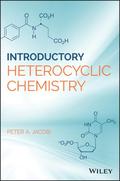Introduction to Heterocyclic Chemistry

1. Auflage Oktober 2018
272 Seiten, Softcover
Wiley & Sons Ltd
A unique approach to a core topic in organic chemistry presented by an experienced teacher to students and professionals
Heterocyclic rings are present in the majority of known natural products, contributing to enormous structural diversity. In addition, they often possess significant biological activity. Medicinal chemists have embraced this last property in designing most of the small molecule drugs in use today. This book offers readers a fundamental understanding of the basics of heterocyclic chemistry and their occurrence in natural products such as amino acids, DNA, vitamins, and antibiotics. Based on class lectures that the author has developed over more than 40 years of teaching, it focuses on the chemistry of such heterocyclic substances and how they differ from carbocyclic systems.
Introductory Heterocyclic Chemistry offers in-depth chapters covering naturally occurring heterocycles; properties of aromatic heterocycles; pi-deficient heterocycles; pi-excessive heterocycles; and ring transformations of heterocycles. It then offers an overview of 1,3-dipolar cycloadditions before finishing up with a back-to-basics section on nitriles and amidines.
* Presents a conversational approach to a fundamental topic in organic chemistry teaching
* Offers a unique look at this core organic chemistry topic via important naturally occurring and/or biologically active heterocycles
* Based on the author's many years of class lectures for teaching at the undergraduate and graduate level as well as pharmaceutical-industry courses
* Clear, concise, and accessible for advanced students of chemistry to gain a fundamental understanding of the basics of heterocyclic chemistry
Introductory Heterocyclic Chemistry is an excellent text for undergraduate and graduate students as well as chemists in industrial environments in chemistry, pharmacy, medicinal chemistry, and biology.
Acknowledgments xi
1 Some Biologically Important Heterocycles of Nature 1
1.1 Vitamins 3
1.2 Antibiotics and Tetrapyrroles 8
References 10
2 Orbitals and Aromaticity; Chemical Reactivity 11
References 15
3 A Prelude to Synthesis 17
References 21
4 pi-Deficient Heterocycles: Some Physical Properties 23
References 25
5 pi-Deficient Heterocycles: De Novo Syntheses 27
5.1 De Novo Syntheses, Pyrimidines 32
5.2 Fused-Ring Systems, Quinolines 33
5.2.1 Isoquinolines 34
References 37
6 pi-Deficient Heterocycles: Introduction of New Substituents: Nucleophilic Substitution 39
References 48
7 pi-Deficient Heterocycles: Introduction of New Substituents: Heterocyclic N-Oxides 49
7.1 Further Reactions of N-Oxides 61
References 73
8 pi-Deficient Heterocycles: Introduction of New Substituents: Quinolines and Isoquinolines 75
References 86
9 pi-Deficient Heterocycles: Manipulation of Existing Substituents 89
9.1 Summary 103
References 105
10 pi-Excessive Heterocycles: General Properties 107
References 114
11 pi-Excessive Heterocycles: De Novo Syntheses 115
11.1 Synthesis of 1,3-Azoles 127
11.2 Synthesis of 1,2-Azoles 131
11.3 Fischer Indole Synthesis 133
References 136
12 pi-Excessive Heterocycles: Introduction of New Substituents 139
References 153
13 Ring Transformations of pi-Excessive Heterocycles: Diels-Alder Reactions 157
References 175
14 Heterocycles as Synthons 177
References 205
15 1,3-Dipolar Cycloadditions--An Overview 207
References 234
16 Back to Basics 239
References 245
17 A Brief Synopsis 247
Index 251


